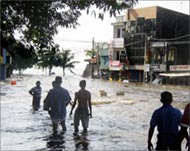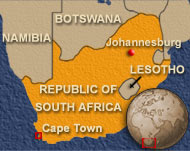S African plane for tsunami victims
The South African government has sent a rescue plane to Thailand for its citizens, while the last effects of the tsunami are felt at Africa’s southern tip.

A rescue plane has left Johannesburg to bring back South Africans stranded on the Thai island of Phuket, a South African foreign ministry spokeswoman has said.
“A 198-seater plane carrying 21 doctors and paramedics and eight others left Johannesburg for Phuket,” Nomfanelo Kota said.
“The main priority of this mission is to get those South Africans who are desperately in need of help, those who are wounded, the children, the sick and the elderly,” she said.
“There are many, many South Africans stranded in the region but we cannot put a number,” Kota said.
“If there is a need to send reinforcements, we will do so after our ambassador in Thailand reassesses the situation,” she said, adding that since the weekend disaster in Asia, the foreign ministry had received more than 2000 calls from people inquiring after their loved ones holidaying in the region.
Continental shelf
At least four South Africans are known to have died and 12 are still missing after the earthquake and tidal wave disaster, the foreign ministry said on Tuesday.
 |
|
Effects of the Asian tsunami were |
Residents and holidaymakers along South Africa’s coastline reported seeing unusual waves at around 7.30pm (0530 GMT) on Monday, according to local media reports.
Professor Frank Shillington from the University of Cape Town‘s oceanography department told Aljazeera.net: “The first report of the effects of the tsunami in South Africa were reportedly seen along the northeast coast at about 3pm.”
“It took longer than it should have [approximately 12 hours], but the delay could have been caused by the continental shelf that exists near coastlines.”
“The continental shelf, further down the south coast, which runs up to 100km wide could have caused what is called an edgewave. This is where a wave becomes trapped or is slowed down by a continental shelf.”
“It still took only three hours to reach Port Elizabeth, which is also proof of the after effects of the tsunami,” Shillington added.
Tsunami energy stream
The tsunami reached the southern-most tip of Africa, close to the Struis river, which is situated at Cape Agullhas, where the Indian and Atlantic oceans meet.
“However, it is unlikely to move on from South Africa. It has reached the end of its energy stream,” said Shillington.
Shillington also said Africa has some benign plates unlike the ones in the Pacific. “These plates are regarded as tectonically safe.”
Some residents say they saw the sea pull back leaving a sandy beach, and five minutes later a large wave almost 2m high sent people running for cover.
Holidaymakers on some rivers at the tip of Africa have also seen waves moving upstream while paddling downstream on the Goukou river.
High tide
Witnesses are convinced that there is some link to the tsunami which caused devastation across Asia.
 |
|
Tsunami is said to be at the end of |
Experts say they are a direct offshoot of the tsunami which has wreaked havoc in southern Asia.
According to other local media reports, the tsunami had reached the South African north coast, at Richards Bay, earlier on Monday. They had moved down the coast, passing through East London, Port Elizabeth, and Plettenberg Bay, moving in a southerly direction along the coastline.
Jonathan Tufts from South Africa‘s National Sea Rescue Institute (NSRI) in Port Elizabeth said the tsunami had caused an exceptionally high tide on the country’s Eastern Cape coastline.
“We believe it was the effect of the earthquake – it gave us a very high tide very quickly,” he said.
Tanzania deaths
Ten swimmers aged between 12 and 20 died soon after the tidal wave triggered by the quake hit Tanzania’s coast on Sunday morning, police in the capital Dar as-Salaam said on Tuesday.
A tourist from Nairobi died on the Kenyan coast at Malindi on Sunday.
And in southeast Madagascar, an estimated 1200 people were made homeless when the sea suddenly rose and engulfed 150 homes.